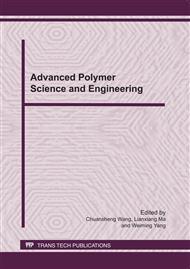p.78
p.85
p.90
p.95
p.99
p.104
p.111
p.117
p.123
Synthesis of Carbon Nanotubes with Typical Structure from the Pyrolysis Flame
Abstract:
Synthesis of carbon nanotubes from V-type pyrolysis flame is a kind of new method. It has potential for carbon nanotubes preparation in mass production. Carbon monoxide was as carbon source and the acetylene/air premixed gas provides heat by combustion. Hydrogen/helium premixed gas acted as diluted and protection gas. Pentacarbonyl iron was served as catalyst. Carbon nanotubes with less impurity and high yield were captured successfully in the V-type pyrolysis flame. The diameter of carbon nanotubes was approximate between 10nm and 20nm, and its length was dozens of microns. The size of catalyst nanoparticles approximately was from 5 nm to 8nm in diameter. This study aims to examine the formation process of typical carbon nanotubes from pyrolysis flame and to characterize their morphology and structure. The morphology and structural of carbon nanotubes were characterized by scanning electron microscope and transmission electron microscopy respectively. Temperature was the key parameter in the process of synthesis carbon nanotubes. The concentration of catalyst had important influence on the synthesis of carbon nanotubes. Sampling time directly determined whether carbon nanotubes formation was completely. The carbon “dissolved-proliferation-separate out” theory can be used to explain that pentacarbonyl iron catalyses carbon monoxide in the process of carbon nanotube formation.
Info:
Periodical:
Pages:
99-103
Citation:
Online since:
March 2011
Authors:
Price:
Сopyright:
© 2011 Trans Tech Publications Ltd. All Rights Reserved
Share:
Citation:


